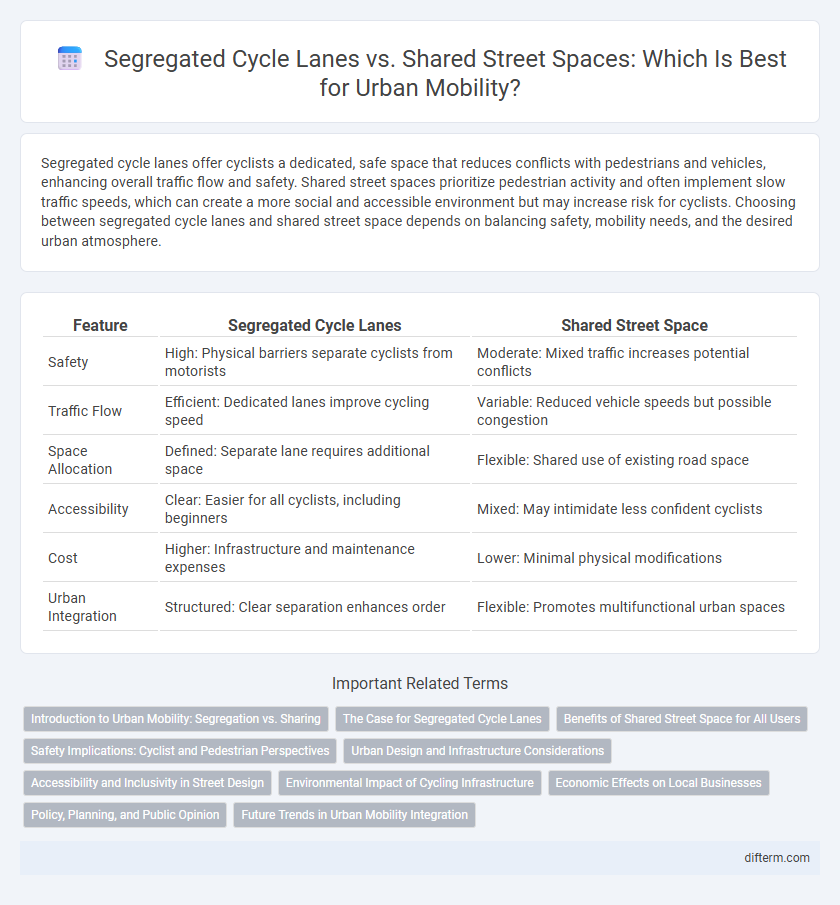Segregated cycle lanes offer cyclists a dedicated, safe space that reduces conflicts with pedestrians and vehicles, enhancing overall traffic flow and safety. Shared street spaces prioritize pedestrian activity and often implement slow traffic speeds, which can create a more social and accessible environment but may increase risk for cyclists. Choosing between segregated cycle lanes and shared street space depends on balancing safety, mobility needs, and the desired urban atmosphere.
Table of Comparison
| Feature | Segregated Cycle Lanes | Shared Street Space |
|---|---|---|
| Safety | High: Physical barriers separate cyclists from motorists | Moderate: Mixed traffic increases potential conflicts |
| Traffic Flow | Efficient: Dedicated lanes improve cycling speed | Variable: Reduced vehicle speeds but possible congestion |
| Space Allocation | Defined: Separate lane requires additional space | Flexible: Shared use of existing road space |
| Accessibility | Clear: Easier for all cyclists, including beginners | Mixed: May intimidate less confident cyclists |
| Cost | Higher: Infrastructure and maintenance expenses | Lower: Minimal physical modifications |
| Urban Integration | Structured: Clear separation enhances order | Flexible: Promotes multifunctional urban spaces |
Introduction to Urban Mobility: Segregation vs. Sharing
Segregated cycle lanes provide dedicated infrastructure that enhances cyclist safety and reduces pedestrian conflicts by clearly separating different modes of transport. Shared street space promotes flexibility and fosters social interaction by integrating cyclists, pedestrians, and vehicles within a common area designed to slow traffic speeds. Urban mobility strategies must balance segregation for safety with sharing for accessibility and community engagement.
The Case for Segregated Cycle Lanes
Segregated cycle lanes significantly enhance cyclist safety by providing dedicated, physically separated space from motor vehicles, reducing the risk of collisions. Studies demonstrate that segregated lanes encourage higher cycling uptake, improving urban mobility while decreasing traffic congestion and pollution. Urban planners prioritize segregated infrastructure to promote equitable, efficient, and sustainable transportation systems.
Benefits of Shared Street Space for All Users
Shared street spaces prioritize pedestrian comfort and safety by reducing vehicle speeds and fostering a more inclusive environment for cyclists, pedestrians, and motorists. These spaces encourage social interaction and improve accessibility, creating a vibrant urban atmosphere that supports local businesses and community activities. Enhanced visibility and mutual awareness among all users help to minimize conflicts and accidents, promoting a safer and more cohesive mobility experience.
Safety Implications: Cyclist and Pedestrian Perspectives
Segregated cycle lanes significantly enhance safety by physically separating cyclists from motor vehicle traffic, reducing collision risks and providing a dedicated space for vulnerable road users. Shared street spaces prioritize pedestrian dominance but require slow vehicle speeds and heightened awareness, often leading to ambiguous right-of-way and potential conflicts between cyclists and pedestrians. Studies show segregated lanes decrease cyclist injuries by up to 40%, while shared spaces demand careful urban design and user cooperation to maintain safety for all parties.
Urban Design and Infrastructure Considerations
Segregated cycle lanes enhance urban design by providing dedicated space that improves cyclist safety and traffic flow, reducing conflicts between vehicles and pedestrians. Shared street space prioritizes pedestrian mobility and social interaction by minimizing physical barriers, though it requires careful traffic calming and signage to ensure cyclist safety. Infrastructure considerations include space allocation, surface materials, and visibility, which directly impact the effectiveness and user experience of both approaches in urban environments.
Accessibility and Inclusivity in Street Design
Segregated cycle lanes enhance accessibility by providing dedicated space for cyclists, reducing conflicts with pedestrians and vehicles, which supports safer and more inclusive street environments. Shared street spaces blend various users but can create barriers for people with disabilities or visual impairments due to the lack of clear demarcation and increased potential for unpredictable interactions. Designing streets with clearly defined, accessible infrastructure ensures equitable mobility for diverse populations, promoting inclusivity across all modes of transport.
Environmental Impact of Cycling Infrastructure
Segregated cycle lanes significantly reduce air pollution by encouraging more people to cycle safely, decreasing reliance on motor vehicles and lowering greenhouse gas emissions. Shared street spaces promote slower vehicle speeds and increased awareness, which can enhance safety but often lead to mixed traffic flows that reduce the overall environmental benefits. Investing in dedicated cycling infrastructure like segregated lanes optimizes urban air quality and supports sustainable mobility goals.
Economic Effects on Local Businesses
Segregated cycle lanes increase foot traffic by providing safer, more attractive routes, leading to higher sales for local businesses through enhanced customer accessibility. Shared street spaces promote slower vehicle speeds and greater pedestrian interaction, which can boost economic activity by encouraging longer stays and increased spending in commercial areas. Studies indicate that segregated lanes often yield more consistent revenue growth, while shared spaces enhance community engagement that supports small business sustainability.
Policy, Planning, and Public Opinion
Segregated cycle lanes reduce conflicts between cyclists and motor vehicles, enhancing safety and encouraging cycling adoption, which aligns with urban mobility policies prioritizing sustainable transport. Shared street space requires careful urban planning to balance diverse road users, often relying on traffic calming measures and public awareness campaigns to promote safer interaction. Public opinion typically favors segregated lanes for clear safety benefits, though shared spaces gain support in low-traffic areas for fostering community interaction and slower vehicle speeds.
Future Trends in Urban Mobility Integration
Segregated cycle lanes offer safer and faster routes for cyclists by physically separating them from motor traffic, driving higher adoption rates in dense urban areas. Shared street spaces prioritize mixed-use interaction, enhancing pedestrian safety and social engagement while encouraging slower vehicle speeds. Future urban mobility trends emphasize integrating both approaches to create flexible, multimodal environments that adapt to evolving transportation needs and promote sustainability.
Segregated cycle lanes vs Shared street space Infographic

 difterm.com
difterm.com